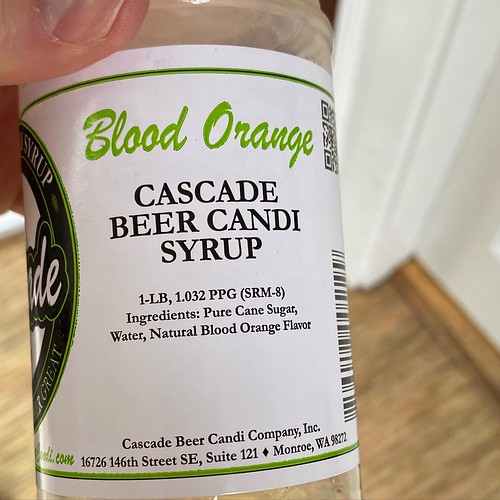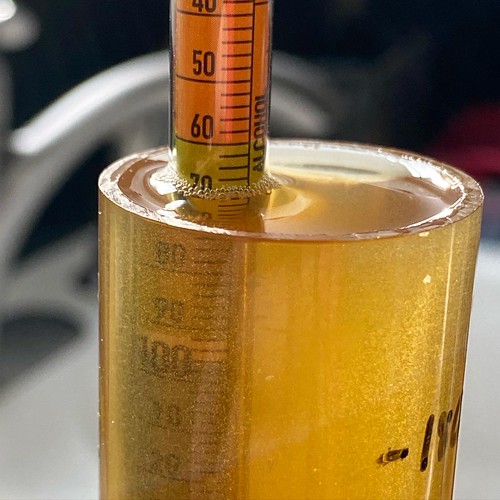Homebrew #98: Zondag Meisje
¶ by Rob FrieselIn service of my 2020 goal to brew a few more new-to-me styles, I decided on a Belgian Blond early on in the year’s brew planning. It’s a style I don’t know too well, but I’ve historically enjoyed Leffe and… why not take a swing at it? And so one Sunday afternoon, Zondag Meisje 1 was born:

It’s probably also worth calling out that I was looking for an excuse to use up some blood orange candi syrup that I’d gotten in a judge’s swag bad after a competition in the fall.

Not that I was going for a strong blood orange impression — but some Belgian style seemed a fair target for that ingredient. Belgian Blond seemed like a style where such a thing wouldn’t be off-limits or otherwise… problematic for the style.
Brew Day
I got my starter going the day before brew day — a single pack of B63 Monastic into 1L of golden light DME-based wort.

The morning of the brew day, I tried to take things nice and slow — milling the grains and collecting water, etc. Mashed in at approx. 145ºF for the first rest (45 min.), before adding the second infusion to raise the temperature up to 160ºF for the second rest.

The rest was… pretty uneventful and boring. Pull the bag and do the squeeze. Get the flame going again for the boil. Half ounce of Warrior to bitter; 1 oz. Styrian Goldings at 5 minutes. Chill and … do the post-boil science.

Collected 5.25 gallons of wort into the fermentor at 1.066 with a kettle efficiency around 82% and a brew house efficiency around 71%.
Good enough for me. Let’s get this yeast pitched.
Fermentation
The 1L starter was pitched when the wort was around 65ºF and I set the controller up to allow it to free-rise into the low-70s (ºF) if it wanted to.
At +13 hours, there was definitely some evidence that fermentation had kicked off, and though temperatures were into the high 60s (ºF), I wasn’t also seeing the high spikes like I’d expected.
At +61 hours, things seemed to be slowing down, so I re-set the controller to raise things to 70±1ºF. My thinking was that by raising the temperature now, before the yeast fully “went to sleep”, I could encourage a more complete attenuation.
Three days later, at +141 hours, I took the first refactometer reading. It read 7.9ºBx which BeerSmith converted to 1.010. (Hmm…. likely F.G., but that’s less than a week, so let’s allow it to really finish up.)
Gave it another week or so before pulling it up out of the chest freezer fermentation chamber to let it settle before packaging. And despite the style guidelines’ call for “generally very clear” beer, I opted out of any gelatin. 2

Shortly thereafter I took the sample for F.G. (indeed, 1.010 with calibrations and offsets) and racked the remainder to a keg to gently carbonate over the next week or so to 2.65 volumes of COâ‚‚.
Overall Impressions
I don’t know that I nailed the style, but it’s a drinkable beer with some fun Belgian character. Not my best beer, and not one that’s likely to win any competitions, but one that I’d be gladly share around.

AROMA. Leads with medium fruity esters – pears and peaches mostly, and also some low soft citrus. Medium-low grainy-sweet malt character. Very low spicy-floral hop notes. A low but distinct perfumy ethanol note is detectable. Faint suspicions of a butterscotch note raise questions about diacetyl, but they’re fleeting and (oddly?) seem to dissipate as it warms. No detectable DMS, nor acetaldehyde.
APPEARANCE. Deep gold bordering on amber. Two centimeter white head with dense foam — eventually collapsed to a thin but stable cap that completely covered the beer. Noticeable haze, but not cloudy or murky.
FLAVOR. Medium-low grainy-sweet malt with toasted accents. Very low floral hop impression, though somewhat stronger retronasally. Moderately strong fruity esters present as pear and orange flesh. Detectable peppery phenol character (now that I think of it: which did not present in the aroma?) Background rose-like alcohol note. Balance is roughly even. Finishes dry. Medium-low bitterness, but firm. No significant detectable off-flavors detected on the palate.
MOUTHFEEL. Medium-light body. Medium-high carbonation; assertive but not zippy. Gentle and moderately low alcohol warming. No significant creaminess. Light but noticeable husky astringency — detectable but not distracting.
OVERALL IMPRESSION. (Very?) Good example of the style with some minor faults that are primarily stylistic. Ester expression seems a little high for style (should be “subtle”); consider watching yeast health, and maybe restrain fermentation temperatures. Check grain freshness and mill gap and mash pH to see if that can correct the astringency. Hops seemed to present somewhat more “floral” than “spicy” — double check varietal selection to better align. There’s also a weird sense that this beer reads like a pale Dubbel (!?!?) — and maybe that’s just the over-expression of the yeast but… think about that.
All that said… it’s hard to think of what I would do differently for next time. Even looking over my own scoresheet notes, I compare those to what I know that I did with my process from my notes and… “Really?” Yeast health? I bought the freshest stuff I could and did a starter. Restrain fermentation temperatures? If anything they were lower than I’d originally planned but… OK. Hop varietal selection? But isn’t Styrian Goldings like the Belgian finishing hop?
:SHRUGGING_EMOJI:
So THAT said… I’d love to get some other opinions about this one before I commit to a “What would I do different next time?” And in the meantime, I’ll enjoy drinking it. Hopefully it lasts long enough through all the COVID-19 quarantine for me to share it with another judge’s palate.
Recipe
The all-grain (BIAB) recipe for Zondag Meisje is as follows:
Water Chemistry
Starting with the Seattle municipal water profile (carbon filtered) as a base:
| Ca | Mg | Na | SO₄ | Cl⁻ | HCO₃⁻ |
|---|---|---|---|---|---|
| 51.1 | 11.9 | 6.0 | 104.5 | 44.4 | 22.9 |
Grist
- 10 lb. Swaen Pilsner malt
- 1 lb. 8 oz. Avangard Vienna malt
- 8 oz. Dingemans Aromatic malt
Fermentables
1 lb. Cascade Blood Orange candi syrup (10 min. late addition)
Hop Schedule
- 0.5 oz. Warrior (60 min.)
- 1 oz. Styrian Goldings (5 min.)
Yeast
Imperial Organic Yeast B63 Monastic (1000 ml starter)
Brew Day
- Collect 14.84 qt. water and heat to 158.6ºF. Mash in; hold at 145ºF for 45 minutes.
- Meanwhile collect 8 qt. water and heat to 200ºF. Infuse and hold at 162ºF for 30 minutes.
- Meanwhile collect 8 qt. water and heat to 188ºF. Infuse and hold at 168ºF for 10 minutes to mash out.
- Remove filter bag from water. Squeeze filter bag to extract as much liquid as possible for wort. No sparge. Pre-boil volume should be 6.83 gallons.
- Bring to a boil. Boil for 60 minutes; follow hop schedule as described above.
- Cool to 70ºF as rapidly as possible. Post-boil volume should be approx. 5.25 gallons.
- Aerate wort; pitch B63 Monastic yeast from starter.
- Start fermentation at 65ºF.
Beyond Brew Day
- Allow fermentation to complete (approx. 2 weeks) at approx. 68-72ºF.
- When fermentation completes, rack to a keg and carbonate to approx. 2.6 vols.
- Enjoy!
Details
Zondag Meisje, a Belgian Blond Ale by Tilde Gravitywerks
| Original Gravity | 1.066 |
| Final Gravity | 1.010 |
| ABV | 7.4% |
| Attenuation | 84.0% |
| IBU | 23 |
| SRM | 5 |
| Links | Flickr |
- Blondie’s got that song “Sunday Girl” and I brewed it on a Sunday so… “What’s Flemish for Sunday Girl??”[↩]
- A friend from my homebrew club was kind enough to remind me that gelatin makes a beer not vegan, and so now that’s a consideration I’ve got. In other words: I want to be able to share with a clear conscience![↩]
About Rob Friesel
Software engineer by day. Science fiction writer by night. Weekend homebrewer, beer educator at Black Flannel, and Certified Cicerone. Author of The PhantomJS Cookbook and a short story in Please Do Not Remove. View all posts by Rob Friesel →2 Responses to Homebrew #98: Zondag Meisje
Pingback: Homebrew #102: Hoarder Intervention #4 | found drama
Leave a Reply